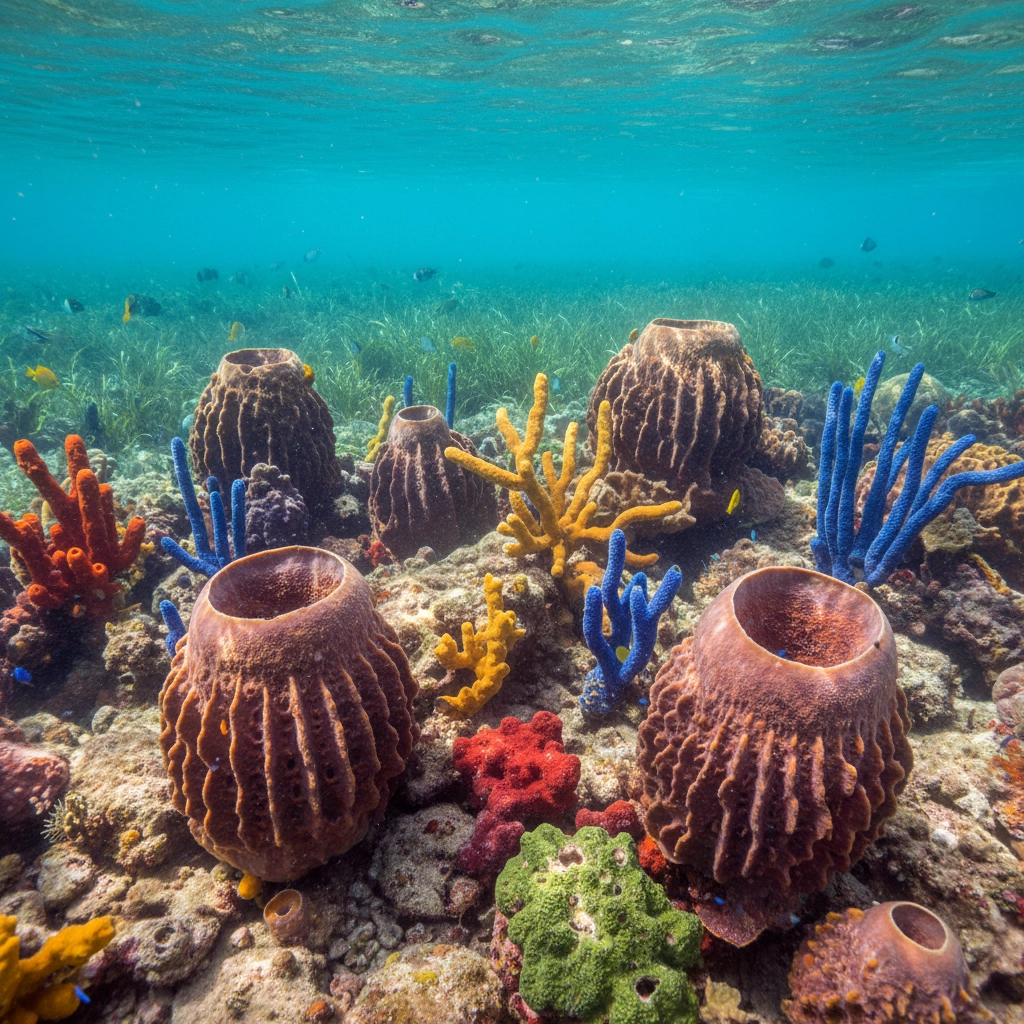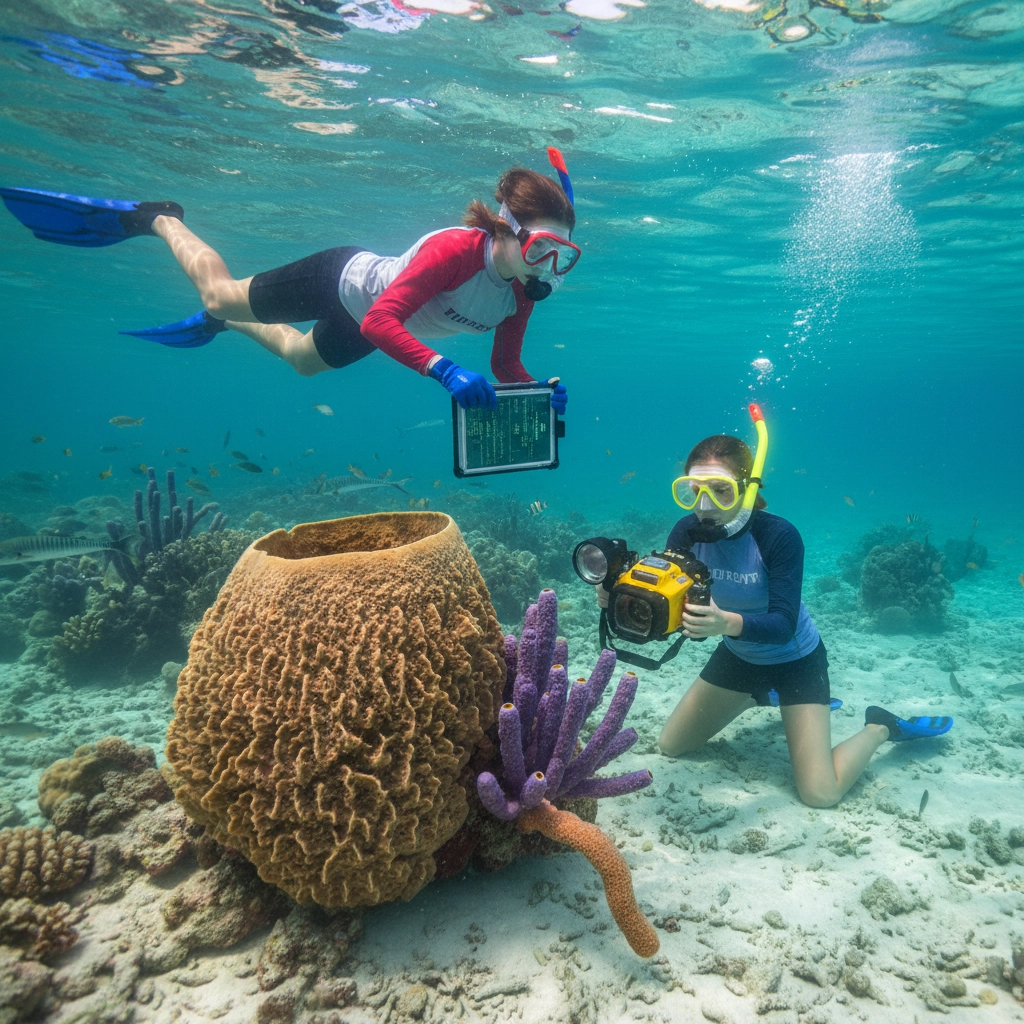Shallow Bays and Sponge Science: Fieldwork in the Florida Keys
- Caleb Mullenix
- Oct 27
- 6 min read
Transforming your students into marine biologists begins with understanding one of the ocean's most underappreciated yet essential organisms: sponges. The shallow bays of the Florida Keys provide an unparalleled living laboratory where students can conduct authentic scientific research while discovering the intricate connections between sponge communities, coral reefs, seagrass beds, and mangrove ecosystems.
Ensuring your students engage with real scientific research: not just observational activities: is of paramount importance for developing critical thinking skills and fostering genuine environmental stewardship. The Florida Keys offer exceptional opportunities for hands-on sponge research that directly contributes to ongoing conservation efforts.
Why Sponge Science Matters: Understanding Ecosystem Engineers
Sponges function as ecosystem engineers in the shallow waters surrounding the Florida Keys, playing critical roles that your students must understand to grasp marine ecosystem complexity. These remarkable filter-feeding organisms process enormous volumes of water daily, cycling nutrients and serving as natural water filtration systems that maintain water quality throughout the shallow bay habitats.
Begin by teaching your students that sponges provide essential nursery habitat for commercially important species, including spiny lobsters, stone crabs, and numerous fish species. This connection between sponge communities and fisheries demonstrates real-world economic and ecological value that resonates with students studying environmental science or marine biology.
Emphasize the importance of sponge diversity in Florida Keys ecosystems. The region hosts over 200 sponge species, each adapted to specific environmental conditions within the shallow bay habitats. Students will discover how different sponge species occupy distinct ecological niches, from wave-exposed areas near coral reefs to protected mangrove creeks.

Conducting Authentic Sponge Research: Student Fieldwork Protocols
Create structured research opportunities that allow your students to contribute meaningful data to ongoing scientific studies. Establish clear protocols for sponge identification, measurement, and habitat documentation that align with professional research standards while remaining accessible to high school students.
Begin student research activities with comprehensive sponge identification training. Provide students with waterproof identification guides and teach them to recognize key morphological features: growth forms (encrusting, massive, branching), surface textures, and color patterns. Students should practice identifying common Florida Keys species including loggerhead sponges, yellow tube sponges, and various encrusting species.
Implement standardized data collection procedures that contribute to larger research initiatives. Students should measure sponge dimensions, document associated organisms, record water depth and habitat characteristics, and photograph specimens using underwater cameras. Emphasize the importance of precise measurements and detailed observations that meet scientific standards.
Develop quantitative sampling techniques appropriate for student researchers. Establish permanent transects in shallow bay areas where students can conduct regular surveys, tracking sponge population changes over time. These longitudinal studies provide valuable data while teaching students about scientific methodology and the importance of consistent data collection.
Snorkeling Techniques for Sponge Research
Ensure your students develop proficient snorkeling skills essential for effective sponge research in shallow bay habitats. Safety considerations must remain paramount throughout all aquatic research activities, requiring comprehensive training and constant supervision.
Begin with shallow water training sessions where students practice basic snorkeling techniques: proper mask fitting, snorkel clearing, and efficient swimming patterns. Students must demonstrate competency in calm, shallow areas before participating in research activities in deeper or more challenging environments.
Teach students specialized underwater observation techniques for sponge research. Emphasize the importance of buoyancy control to avoid damaging fragile sponge communities while conducting close-up examinations. Students should learn to hover motionlessly above sponge colonies, using minimal fin kicks to maintain position without disturbing the substrate.
Provide waterproof data collection materials and teach students to record observations while snorkeling. Underwater writing slates, waterproof data sheets, and underwater cameras enable students to document their findings without returning to the surface repeatedly. This approach maximizes research time while maintaining data quality.

Ecosystem Connections: Linking Sponges to Coral Reefs and Seagrass Beds
Help your students understand the complex interconnections between sponge communities, coral reefs, seagrass beds, and mangrove ecosystems that characterize Florida Keys marine environments. These connections demonstrate how seemingly separate habitats function as integrated ecosystem components.
Examine the relationship between sponge communities and nearby coral reefs. Students should observe how sponges occupy different zones within the reef ecosystem, from shallow back-reef areas to deeper fore-reef environments. Many sponge species depend on coral reef structures for attachment sites while contributing to reef ecosystem function through filtration and nutrient cycling.
Investigate connections between sponge habitats and seagrass beds. Students will discover how sponges growing on hard-bottom areas adjacent to seagrass meadows process nutrients that support seagrass productivity. The filtered water from sponge communities creates optimal conditions for seagrass photosynthesis and growth.
Document the relationships between sponge communities and mangrove ecosystems. Students should examine how mangrove-derived nutrients support sponge growth while sponge filtration removes excess nutrients that could otherwise cause harmful algal blooms in mangrove creeks and shallow bays.
Wildlife Interactions: Sponges as Habitat Providers
Create opportunities for students to observe and document wildlife species that depend on sponge communities for shelter, feeding areas, and nursery habitat. These observations reinforce understanding of sponge ecological importance while providing exciting wildlife encounters that motivate continued learning.
Focus student attention on fish species commonly associated with sponge habitats. Students should look for juvenile snappers, grunts, and other reef fish species that use sponge communities as nursery areas. Document cleaning stations where larger fish visit sponges to have parasites removed by cleaner fish species.
Encourage students to observe invertebrate communities living within and on sponge colonies. Many crabs, shrimp, worms, and other invertebrates depend on sponges for shelter and feeding opportunities. Students can carefully examine sponge surfaces to discover these often-hidden community members.
Watch for interactions between sponges and sea turtles or sharks that may visit shallow bay habitats. While these encounters cannot be guaranteed, students should understand how sponge communities contribute to the broader ecosystem that supports these charismatic marine species.

Hands-On Experiments: Understanding Sponge Biology
Design controlled experiments that allow students to investigate sponge biology and ecological function while adhering to research permit requirements and environmental protection guidelines. These experiments should provide measurable results that demonstrate scientific principles.
Conduct filtration rate experiments to quantify how efficiently different sponge species filter water. Students can measure water clarity changes when sponges are present versus absent in controlled containers, calculating filtration rates and comparing results between species. Ensure all sponges are returned to their natural habitat immediately after experimentation.
Investigate sponge growth rates by establishing permanent monitoring plots where students measure specific sponge colonies over time. Provide students with calipers and teach proper measurement techniques that allow growth rate calculations. These longitudinal studies contribute valuable data to ongoing research while teaching students about organism life cycles.
Examine sponge regeneration capabilities through careful observation of naturally damaged specimens. Students can document healing processes in sponges that have experienced partial tissue loss due to natural causes, learning about remarkable regenerative abilities that distinguish sponges from other organism groups.
Water Quality Connections: Sponges as Environmental Indicators
Teach students to use sponge communities as indicators of ecosystem health and water quality in shallow bay environments. This approach connects sponge research to broader environmental monitoring efforts while demonstrating practical applications of biological research.
Establish protocols for assessing sponge community health in relation to water quality parameters. Students should measure temperature, salinity, dissolved oxygen, and turbidity in areas with healthy versus degraded sponge communities. These data help students understand environmental factors that influence sponge survival and growth.
Document the effects of freshwater discharge on sponge communities in areas where canals or streams enter shallow bays. Students can compare sponge diversity and abundance in areas with different salinity levels, learning how freshwater inputs affect marine organisms adapted to stable salinity conditions.
Investigate the relationship between sponge health and nutrient levels in shallow bay waters. Areas with excessive nutrient input from land-based sources often support different sponge communities than pristine areas, providing students with real-world examples of human environmental impacts.
Conservation Applications: Student Research Contributing to Management
Connect student research activities to ongoing conservation efforts in the Florida Keys, demonstrating how their work contributes to environmental protection and restoration initiatives. This connection provides purpose and motivation while teaching students about the practical applications of scientific research.
Participate in sponge restoration monitoring programs where student data contributes to evaluating restoration success. Many organizations working in the Florida Keys welcome student participation in data collection efforts, providing authentic research experiences while supporting conservation goals.
Engage students in habitat mapping activities that document sponge community distribution and abundance across shallow bay environments. These maps support marine protected area management and help identify areas requiring special protection or restoration attention.
Encourage students to present their research findings to local environmental organizations, school boards, or community groups. These presentations develop communication skills while raising awareness about marine conservation issues and the importance of protecting shallow bay ecosystems.
Preparing your students for meaningful sponge research in the Florida Keys involves careful planning, comprehensive safety protocols, and structured learning activities that connect field experiences to broader environmental concepts. Through hands-on research, students develop scientific skills while contributing to our understanding of these remarkable marine ecosystems, fostering the next generation of marine scientists and environmental stewards.



Comments